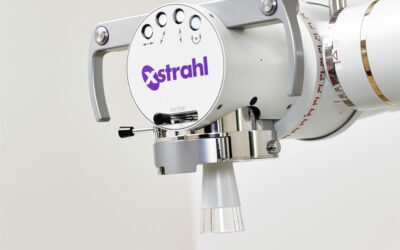PURPOSE: In preclinical radiation research, it is challenging to localize soft tissue targets based on cone beam computed tomography (CBCT) guidance. As a more effective method to localize soft tissue targets, we developed an online bioluminescence tomography (BLT)...
Resources
Novel treatment options for nonmelanoma skin cancer: focus on electronic brachytherapy
Nonmelanoma skin cancer (NMSC) is an increasing health care issue in the United States, significantly affecting quality of life and impacting health care costs. Radiotherapy has a long history in the treatment of NMSC. Shortly after the discovery of X-rays and...
Proposal for a Simple and Efficient Monthly Quality Management Program Assessing the Consistency of Robotic Image-Guided Small Animal Radiation Systems
Modern pre-clinical radiation therapy (RT) research requires high precision and accurate dosimetry to facilitate the translation of research findings into clinical practice. Several systems are available that provide precise delivery and on-board imaging capabilities,...
microRNA-34a promotes DNA damage and mitotic catastrophe.
Efficient and error-free DNA repair is critical for safeguarding genome integrity, yet it is also linked to radio- and chemoresistance of malignant tumors. miR-34a, a potent tumor suppressor, influences a large set of p53-regulated genes and contributes to p53-mediated apoptosis. However, the effects of miR-34a on the processes of DNA damage and repair are not entirely understood. We explored tet-inducible miR-34a-expressing human p53 wild-type and R273H p53 mutant GBM cell lines, and found that miR-34a influences the broad spectrum of 53BP1-mediated DNA damage response. It escalates both post-irradiation and endogenous DNA damage, abrogates radiation-induced G 2/M arrest and drastically increases the number of irradiated cells undergoing mitotic catastrophe. Furthermore, miR-34a downregulates 53BP1 and inhibits its recruitment to the sites of DNA double-strand breaks. We conclude that whereas miR-34a counteracts DNA repair, it also contributes to the p53-independent elimination of distressed cells, thus preventing the rise of genomic instability in tumor cell populations. These properties of miR-34a can potentially be exploited for DNA damage-effecting therapies of malignancies.
Kofman AV, Kim J, Park SY, Dupart E, Letson C, Bao Y, Ding K, Chen Q, Schiff D, Larner J, Abounader R.
Download Paper
Radiotherapy for benign disease; assessing the risk of radiation-induced cancer following exposure to intermediate dose radiation
Most radiotherapy (RT) involves the use of high doses (>50 Gy) to treat malignant disease. However, low to intermediate doses (approximately 3–50 Gy) can provide effective control of a number of benign conditions, ranging from inflammatory/proliferative disorders...
Systemic Tolerance Mediated by Melanoma Brain Tumors Is Reversible by Radiotherapy and Vaccination
PURPOSE: Immune responses to antigens originating in the central nervous system (CNS) are generally attenuated, as collateral damage can have devastating consequences. The significance of this finding for the efficacy of tumor-targeted immunotherapies is largely...
Selective Inhibition of Parallel DNA Damage Response Pathways Optimizes Radiosensitization of Glioblastoma Stem-like Cells.
Glioblastoma is the most common form of primary brain tumor in adults and is essentially incurable. Despite aggressive treatment regimens centered on radiotherapy, tumor recurrence is inevitable and is thought to be driven by glioblastoma stem-like cells (GSC) that are highly radioresistant. DNA damage response pathways are key determinants of radiosensitivity but the extent to which these overlapping and parallel signaling components contribute to GSC radioresistance is unclear. Using a panel of primary patient-derived glioblastoma cell lines, we confirmed by clonogenic survival assays that GSCs were significantly more radioresistant than paired tumor bulk populations. DNA damage response targets ATM, ATR, CHK1, and PARP1 were upregulated in GSCs, and CHK1 was preferentially activated following irradiation. Consequently, GSCs exhibit rapid G2-M cell-cycle checkpoint activation and enhanced DNA repair. Inhibition of CHK1 or ATR successfully abrogated G2-M checkpoint function, leading to increased mitotic catastrophe and a modest increase in radiation sensitivity. Inhibition of ATM had dual effects on cell-cycle checkpoint regulation and DNA repair that were associated with greater radiosensitizing effects on GSCs than inhibition of CHK1, ATR, or PARP alone. Combined inhibition of PARP and ATR resulted in a profound radiosensitization of GSCs, which was of greater magnitude than in bulk populations and also exceeded the effect of ATM inhibition. These data demonstrate that multiple, parallel DNA damage signaling pathways contribute to GSC radioresistance and that combined inhibition of cell-cycle checkpoint and DNA repair targets provides the most effective means to overcome radioresistance of GSC.
Shafiq U Ahmed, Ross Carruthers, Lesley Gilmour, Salih Yildirim, Colin Watts and Anthony J Chalmers
Download Paper
Intravesical Liposomal Tacrolimus Protects against Radiation Cystitis Induced by 3-Beam Targeted Bladder Radiation
PURPOSE: We primarily determined whether the small animal radiation research platform could create a rat radiation cystitis model via targeted bladder irradiation (phase I). The response to treating early phase radiation cystitis in rats with transurethral catheter...
Randomized multicenter follow-up trial on the effect of radiotherapy on painful heel spur (plantar fasciitis) comparing two fractionation schedules with uniform total dose: first results after three months’ follow-up
BACKGROUND: Our first trial on radiotherapy for painful heel spur published in 2012 comparing the analgesic effect of a standard dose (6 × 1.0Gy within three weeks) to that of a very low one (6 × 0.1Gy within three weeks) resulted in a highly significant superiority...
Contact Us



